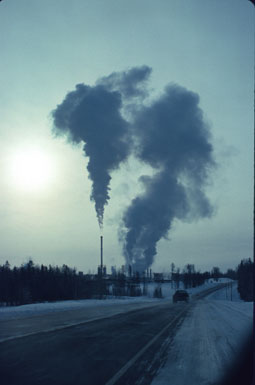
[Last in a three-part series on B.C.'s oil and gas future]
When British Columbia Premier Gordon Campbell traveled to Calgary in April 2002 to speak to members of the Canadian Association of Petroleum Producers he had one thing on his mind: to convince everyone that B.C.'s energy-rich northeast corner was the place to be.
One of the many cards Campbell played from a hand loaded with industry inducements (tax breaks, speedier permits, fewer inspections and drilling easements) was what he called the biggest natural gas find in the country's recent history - a one trillion cubic foot monster called Ladyfern.
"We are very proud of the Ladyfern discovery just made in northeastern British Columbia. It's the largest discovery in the last 15 years in Canada, and it puts B.C. back on the map for people examining our oil and gas reserves," Campbell crowed. "One Ladyfern well is producing 100 million cubic feet of natural gas a day, and others are producing 60 million. By itself, Ladyfern represents 25 per cent of British Columbia's total production. There are many more Ladyferns in northeastern British Columbia - and we intend to find them."
Just over a year later, however, Campbell's boasts were shown to be a tad inflated. In the pages of Canadian Business magazine, Calgary author and energy industry follower, Andrew Nikiforuk, outlined how Alberta-based energy companies had come to a far different conclusion about the riches underlying a forlorn boggy forest 100 kilometres north of Fort St. John.
"...like a moose devoured by wolves, Ladyfern is now little more than a hill of bones. The flock of helicopters that serviced the great gas rush are gone. Roads that supported 1,000 service vehicles a day now see fewer than two dozen trucks. Bonanza wells that pumped enough gas to heat small cities now cough up salt water. What many analysts initially talked up as an 'elephant play' of one trillion cubic feet has been downsized to a 400-billion-cubic-foot warthog - or less."
As events at Ladyfern attest, the business of identifying just how many underground riches are there to be exploited is a tricky one. The uncertainty makes efforts to develop those resources in a rational way extremely difficult. Throw politics into the mix and chances increase exponentially that a gold rush mentality sets in and that the resource is developed too quickly. When that happens, the ultimate losers are the taxpayer and energy user.
Expecting an elephant
When the initial mapping and first test results came in from the Ladyfern area in 2000 word quickly spread inside the B.C. government and among Alberta's energy companies of a massive gas deposit. Before long, people were talking about a play of 1 trillion cubic feet trapped a few thousand metres below the ground in a rock formation that hundreds of millions of years earlier had been a coral reef.
That would have meant Ladyfern held more than three percent of all the remaining known and believed recoverable natural gas reserves in the B.C. portion of the Western Canada basin
Initially, it looked like Ladyfern was going to live up to Campbell's promotion and then some. Craig Gibson, whose job it is to try and see that gas reserves are developed rationally, said the early results from producing wells in the area were off the scale.
"When we first saw the numbers it was kind of 'did somebody slip a decimal here?' They were so good it was almost unbelievable," Gibson told The Tyee during an interview in his Victoria office. But Gibson, who is director of the B.C. Oil and Gas Commission's Resource Conservation Branch, said things soon changed.
Motivated by a desire for quick cash and lots of it, political decisions were made to sell the underground rights to lots of small parcels of publicly owned land in the Ladyfern area. The sales, combined with rapidly spreading word about spectacular test results at Ladyfern (secrets don't remain so for long in the energy world), touched off a frenzy of bidding activity and before long roads were being punched through the forest, all pointing to Ladyfern.
Finding a warthog
As more and more wells came on line, unforeseen problems emerged. Using his green desk blotter as a crude representation of the Ladyfern area, Gibson placed the forefinger of his right hand in the upper right hand corner of the blotter and his other forefinger in the bottom left corner.
"The gas is so mobile and moves so easily that when this guy started producing over here, gas in the reservoir started to move toward that well, so that this fellow over here was able to see a pressure drop," Gibson explained.
Gibson went on to describe Ladyfern as an unusual "dual porosity" reservoir with a shallow island of dense rock in the centre where the gas was much harder to extract and a surrounding lagoon of much more porous rock. In the outer ring or lagoon spectacular draws of gas were achieved (the Nikiforuk article noted that 20 of Ladyfern's wells poured as much gas onto the market as 10,000 normal wells). But on the island, things were less than spectacular. As the island began to be developed, Ladyfern's potential was quickly downgraded from 1 trillion cubic feet of recoverable gas to today's best estimate of 400 billion cubic feet.
Faster drilling can yield less
Other problems surfaced at Ladyfern too, problems far from unique and confronted by all companies and government regulators when plans are made to extract natural gas, oil or coalbed methane.
"There's never a perfect recovery of petroleum or natural gas from the earth," Kirk Osadetz, a geologist with the Canadian Geological Survey in Calgary told The Tyee. "In many cases, primary recoveries in oilfields can be anywhere from say 30 to 60 per cent of the oil that's in place. So up to 70 per cent can be left behind. On the gas side, typically recoveries would vary quite a lot because of the nature of the reservoir and could be 50 to 90 per cent."
One of the most common factors limiting the amount of oil or gas that can be extracted is water. Imagine a slice of underground rock containing reserves of gas or oil. The grains in the rock are much like ping pong balls dropped into a box. In the spaces between the balls gas and or oil will be found. But so too will water.
The water will be found close to the grains, while the fossil fuel fills in the residual space. As the gas is extracted, however, the water moves. And as it migrates, it may come to occupy the space where the balls touch. When that happens, the gas is trapped and cannot be extracted. The end result is that a well ends up producing less and less gas. And before long it may be coughing up nothing but water.
"If you limit the rate of production hopefully you'll be able to get more gas out," Gibson explains.
No way of knowing
Wells are watering up at Ladyfern. But Gibson says that doesn't mean the OGC's plans for extracting the maximum amount of gas at the site are all wet.
He says that British Columbians will see a 90 per cent recovery at Ladyfern. But it will be 90 per cent based on a revised estimate of 400 billion cubic feet of gas, not the 1 trillion cubic feet originally thought to be there. There was no way of knowing what the true picture was at Ladyfern, he says, until the companies got in there and began drilling in earnest.
As for what tools are at his disposal to limit developments in order to conserve and stretch out gas production as long as possible, Gibson said that as a rule companies are not allowed to place more than one gas well on each square mile of land. And that "daily gas allowances" or DGAs (essentially restrictions on the amount of gas that can be extracted on any given day) can be made a condition of any approval under a number of different circumstances. Those circumstances are outlined in regulations under B.C.'s Petroleum and Natural Gas Act, and include instances where companies are producing gas from a pool "with a suspected water drive", as was the case at Ladyfern. And, more broadly, any circumstances where "conservation is an issue."
No DGAs were put in place at Ladyfern. However, the well density remained within legal limits.
Full bore future ?
In the final analysis, it may prove the case that political decisions to sell off underground rights and hype Ladyfern's riches contributed to a situation in which the reservoir's resources were not developed in a rational, conservation-oriented way. But that isn't something Gibson or other at the OGC can answer to.
You might think of Gibson's position as that of a traffic cop. He's there to hand out tickets and maintain order in the flow of traffic. But he didn't say where the highway should be built. Or, for that matter, whether it should be built at all.
At Ladyfern the big decisions that prompted the rush of development were made at the political level. The result was that more than a few roads got built, making the job of the traffic cops very, very difficult.
And if Campbell's pronouncements at Calgary two years ago are any indication, the traffic cops will be a lot busier in the months and years ahead.
"The energy industry is booming in our province. We had an increase of 22 per cent in size in 2002 over 2001. We know that we have reserves: 17 per cent of all natural gas reserves in the Western Canada basin are in British Columbia. Yet only six per cent of the total number of wells are in our province. Clearly we have a job to do, and we want to work with you to make sure that we can capitalize on those assets and those benefits."
While we can, that is.
Freelance writer and researcher Ben Parfitt lives in Victoria. He is a frequent writer and commentator on natural resource, business, environmental and social justice issues for a variety of publications and author of Forest Follies: Adventures and Misadventures in the Great Canadian Forest. ![]()
















Tyee Commenting Guidelines
Comments that violate guidelines risk being deleted, and violations may result in a temporary or permanent user ban. Maintain the spirit of good conversation to stay in the discussion.
*Please note The Tyee is not a forum for spreading misinformation about COVID-19, denying its existence or minimizing its risk to public health.
Do:
Do not: